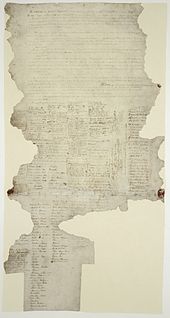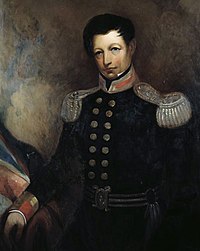William Hobson
William Hobson (born September 26, 1793 in Waterford , Ireland , † September 10, 1842 in Auckland , New Zealand ) was the first governor of the British colonies of New Zealand, based in New Zealand and co-author of the Treaty of Waitangi .
childhood
William Hobson was born on September 26, 1793 (some sources incorrectly state 1792) as the third of five boys. There were also three sisters, making the family of Samuel Hobson and his wife Martha, née Jones, a total of ten. Hobson's father was an assistant paralegal for County Cork and was benevolent to the children, while his mother, Hobson later recalled, was very strict about that.
At the age of only 9, he enlisted in the Royal Navy and served as a second class volunteer on the frigate La Virginie from August 25, 1803. As his first assignment he took part in the naval blockade in the North Sea during the Napoleonic War and was assigned to the West Indies as a senior ensign in April 1806 . After 10 years of service at sea, he was promoted to lieutenant in April 1813 , took part in the British-American War and was part of the squadron with his ship that brought Napoleon into exile in St. Helena in 1815 .
After an 18-month hiatus, he was given the command to take action against piracy in the waters of the West Indies, was captured by pirates in 1821 , was released, was recaptured in July 1823 and finally escaped captivity with his crew members through their own efforts. While in the West Indies areas, he developed yellow fever three times, which he suffered from throughout his life. He was appointed commandant on March 18, 1824 and retired four years later in July 1828.
family
During his time on the West Indies, he met the daughter of the Scottish West India merchant Robert Wear Elliott. On 17 December 1827 he married his wife Eliza in Nassau on the Bahamas and went to his temporary retirement following, with her back to Plymouth to England and visited occasionally his family and home in Ireland. His first daughter was born in March 1830. In total, they had four daughters and one son.
When Lord Auckland became the first Lord Commissioner of the Admiralty , Hobson got a promoter . Auckland dispatched him to the East Indies in 1834 and gave him command of the frigate Rattlesnake , which he gladly accepted. Back into service, he was two years later, the Governor of New South Wales , Sir Richard Bourke recommended. Subordinated to him, Hobson set out in 1836 to examine the port of Port Jackson and give recommendations for an expansion. Another month later he was seconded to Port Phillip in Victoria , where a new colony was founded and, thanks to his services there, Hobsons Bay , a part of Melbourne, was named after him in his honor.

Use in New Zealand
In early 1837, James Busby warned that the wars and conflicts among the Māori in New Zealand could endanger the British settlers . Hobson, now more in demand than ever, was immediately sent to New Zealand by Governor Bourke to clarify the situation and protect British settlers. Hobson reached the Bay of Islands on May 26th of that year, met various Māori chiefs, prominent settlers and missionaries , prepared a report, and sailed back to England in 1838 . Once there, he made the proposal to the Colonial Office to set up a system in New Zealand similar to that in the East Indies , to set up trading establishments and to negotiate a treaty with the Māori that would secure England's land. The Colonial Office , initially not very interested in New Zealand, decided to appoint an envoy from the British government as British consul in New Zealand and to enter into negotiations with the Māori.
Deputy Governor of New Zealand
The choice fell on Hobson, who accepted in February 1839. In amendment, Hobson was now subordinate to the new Governor of New South Wales , George Gipps, as Lieutenant-Governor. On August 25, 1839 Hobson sailed with his assignment to Sydney and after consultation with Governor Gipps at the beginning of 1840 to New Zealand, where he reached the Bay of Islands on January 29, 1840. He invited all northern Māori chiefs to a meeting on February 5th in Waitangi and after extensive discussions the treaty, which was to go down in New Zealand's history as the Waitangi Treaty, was signed the following day . Hobson wanted to organize more meetings in the country and get the signature and support for this contract from the other chiefs, but on March 1, 1840, he suffered a stroke from which he was slow to recover. For example, Lieutenant-Colonel Thomas Bunbury was sent to the aid of Governor Gipps on April 16, who then traveled across the country to collect signatures under the treaty. This copy of the treaty is often referred to as the Herald-Bunbury Treaty Copy because Bunbury sailed the coast with the Harald .
Governor of New Zealand
After Hobson got better, he was appointed governor in May 1841, the first governor of New Zealand . This gave Hobson his own legislative power and his own government. But not enough that his health continued to bother him, not all Māori chiefs had accepted the contract and some of them opposed it. Since Hobson had no military powers in his office, all agreements with all parties, including the Māori, were based on the goodwill agreement. That did not make governing easy for him, nor did it make it easier to represent the interests of the United Kingdom. Though Hobson was instructed by the Colonial Office to maintain strict spending controls, the administrative costs got out of hand. Then there were rash land purchases and the fact that he signed laws to the detriment of the treasury that he was not authorized to make. To make matters worse, the New Zealand Company , even in trouble, took the opportunity to attack the administration wherever they could and to demand the replacement of Hobson. Eventually the Colonial Office decided to recall Hobson on February 28, 1843. He was spared this humiliation, however, because he died on September 10, 1842 in Auckland and was buried in the old historic cemetery Symonds Street Cemetery in Auckland.
As governor, Hobson was not particularly positive. His greatest achievement, however, was to have negotiated the Waitangi Treaty. His wife died in 1876.
According to him, which is Hobsons Bay named in Australia.
Web links
- KA Simpson : Hobson, William . In: Dictionary of New Zealand Biography . Ministry for Culture & Heritage , September 1, 2010, accessed August 20, 2012 .
- Alexander Hare McLintock : Hobson, William . In: An Encyclopaedia of New Zealand . Ministry for Culture & Heritage , April 22, 2009, accessed August 20, 2012 .
- Captain William Hobson, RN . The Governor-General,accessed August 20, 2012.
Individual evidence
- ^ The Herald-Bunbury Treaty Copy - Signatories to the Treaty of Waitangi . In: New Zealand History Online . Ministry for Culture & Heritage , November 24, 2006, archived from the original on February 16, 2012 ; accessed on January 20, 2016 (English, original website no longer available).
| predecessor | Office | successor |
|---|---|---|
|
Governor of New Zealand 1841–1842 |
Robert FitzRoy |
| personal data | |
|---|---|
| SURNAME | Hobson, William |
| BRIEF DESCRIPTION | Governor of New Zealand |
| DATE OF BIRTH | September 26, 1793 |
| PLACE OF BIRTH | Waterford , Ireland |
| DATE OF DEATH | September 10, 1842 |
| Place of death | Auckland , New Zealand |


